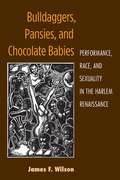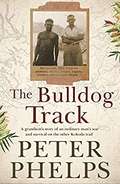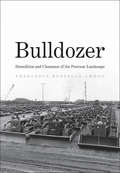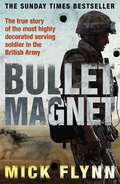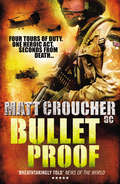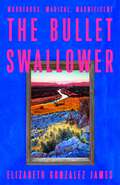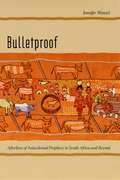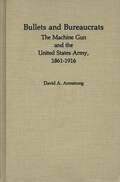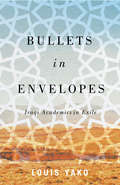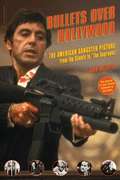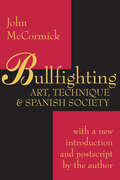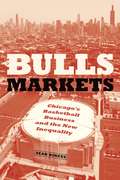- Table View
- List View
Bulldaggers, Pansies, and Chocolate Babies: Performance, Race, and Sexuality in the Harlem Renaissance (Triangulations: Lesbian/Gay/Queer Theater/Drama/Performance)
by James F Wilson"James F. Wilson uncovers fascinating new material on the Harlem Renaissance, shedding light on the oft-forgotten gay and lesbian contributions to the era's creativity and Civil Rights. Extremely well researched, compellingly written, and highly informative." ---David Krasner, author of A Beautiful Pageant: African American Theatre, Drama, and Performance in the Harlem Renaissance, 1910-1927 Bulldaggers, Pansies, and Chocolate Babies shines the spotlight on historically neglected plays and performances that challenged early twentieth-century notions of the stratification of race, gender, class, and sexual orientation. On Broadway stages, in Harlem nightclubs and dance halls, and within private homes sponsoring rent parties, African American performers of the 1920s and early 1930s teased the limits of white middle-class morality. Blues-singing lesbians, popularly known as "bulldaggers," performed bawdy songs; cross-dressing men vied for the top prizes in lavish drag balls; and black and white women flaunted their sexuality in scandalous melodramas and musical revues. Race leaders, preachers, and theater critics spoke out against these performances that threatened to undermine social and political progress, but to no avail: mainstream audiences could not get enough of the riotous entertainment. Many of the plays and performances explored here, central to the cultural debates of their time, had been previously overlooked by theater historians. Among the performances discussed are David Belasco's controversial production of Edward Sheldon and Charles MacArthur's Lulu Belle (1926), with its raucous, libidinous view of Harlem. The title character, as performed by a white woman in blackface, became a symbol of defiance for the gay subculture and was simultaneously held up as a symbol of supposedly immoral black women. African Americans Florence Mills and Ethel Waters, two of the most famous performers of the 1920s, countered the Lulu Belle stereotype in written statements and through parody, thereby reflecting the powerful effect this fictional character had on the popular imagination. Bulldaggers, Pansies, and Chocolate Babies is based on historical archival research including readings of eyewitness accounts, newspaper reports, songs, and playscripts. Employing a cultural studies framework that incorporates queer and critical race theory, it argues against the widely held belief that the stereotypical forms of black, lesbian, and gay show business of the 1920s prohibited the emergence of distinctive new voices. Specialists in American studies, performance studies, African American studies, and gay and lesbian studies will find the book appealing, as will general readers interested in the vivid personalities and performances of the singers and actors introduced in the book. James F. Wilson is Professor of English and Theatre at LaGuardia Community College and the Graduate Center of the City University of New York.
The Bulldog Track: A grandson's story of an ordinary man's war and survival on the other Kokoda trail
by Peter PhelpsThis is the story of Tom Phelps and the 'other Kokoda Track'. Seventy-five years later, Tom's grandson, award-winning actor and writer Peter Phelps, is sharing this inspiring tale of resilience and survival.March 1942: The world is at war. Too old to fight and with jobs scarce at home, Tom Phelps found work as a carpenter in the goldfields of the New Guinea Highlands. No one expected the Japanese to attack in the Pacific. But they did.Tom and his mates weren't going to hang around and wait to be killed. With escape routes bombed by the Japanese, their only option was to try to reach safety by foot, through some of the most rugged terrain on Earth - the Bulldog Track.Back home in Sydney, Rose Phelps, their son, George, and three daughters, Joy, Shirley and Ann, waited for news of Tom's fate. George watched the horrors of war unfold on newsreels knowing his dad was 'over there'.Travelling by foot, raft, canoe, schooner, train, luck and courage, Tom Phelps, half-starved and suffering malaria, would eventually make it home. His stories of New Guinea would lead his son and grandson to their own experiences with the country. The Bulldog Track is a grandson's story of an ordinary man's war. It is an incredible tale of survival and the indomitable Aussie spirit.
Bulldozer: Demolition and Clearance of the Postwar Landscape
by Francesca Russello AmmonAlthough the decades following World War II stand out as an era of rapid growth and construction in the United States, those years were equally significant for large-scale destruction. In order to clear space for new suburban tract housing, an ambitious system of interstate highways, and extensive urban renewal development, wrecking companies demolished buildings while earthmoving contractors leveled land at an unprecedented pace and scale. In this pioneering history, Francesca Russello Ammon explores how postwar America came to equate this destruction with progress. The bulldozer functioned as both the means and the metaphor for this work. As the machine transformed from a wartime weapon into an instrument of postwar planning, it helped realize a landscape-altering “culture of clearance.” In the hands of the military, planners, politicians, engineers, construction workers, and even children’s book authors, the bulldozer became an American icon. Yet social and environmental injustices emerged as clearance projects continued unabated. This awareness spurred environmental, preservationist, and citizen participation efforts that have helped to slow, though not entirely stop, the momentum of the postwar bulldozer.
Bullecourt 1917: Breaching the Hindenburg Line (Spellmount Ser.)
by Paul KendallIn the spring of 1917 the Arras offensive was begun to break the stalemate of the Western Front by piercing the formidable German defences of the Hindenburg Line. The village of Bullecourt lay at the southern end of the battle front, and the fighting there over a period of six weeks from 11 April until late May 1917, epitomised the awful trench warfare of World War I. In Bullecourt 1917, Paul Kendall tells the stories of the fierce battles fought by three British and three Australian divisions in an attempt to aid Allenby’s Third Army break out from Arras. Approximately 10,000 Australian and 7,000 British soldiers died, many of whom were listed as missing and have no known grave. The battle caused much consternation due to the failure of British tanks in supporting Australian infantry on 11 April, but despite the lack of tank and artillery support the Australian infantry valiantly fought their way into the German trenches. It took a further six weeks for British and Australian infantry to capture the village. This book tells the story of this bitter battle and pays tribute to the men who took part. Crucially, Paul Kendall has contacted as many of the surviving relatives of the combatants as he could, to gain new insight into those terrible events on the Hindenburg Line.
Bulleit Proof: How I Took a 150-Year-Old Family Recipe and a Revolver, and Disrupted the Entire Liquor Industry One Bottle, One Sip, One Handshake at a Time
by Tom BulleitThe compelling story of how one man took a 150-year-old family recipe and disrupted the entire liquor industry one sip, one bottle, one handshake at a time Tom Bulleit stood on a stage before a thousand people inside a tent the size of a big-top. It was both his thirtieth wedding anniversary and his birthday. But there was another thing to celebrate: the dedication of the new Bulleit Distillery in Shelbyville, Kentucky. His great-great-grandfather, Augustus, created his first batch of Bulleit Bourbon around 1830. A century and a half later, Tom fulfilled his lifelong dream, revived the old family bourbon recipe, and started Bulleit Distilling Company. Eventually, Tom was named a member of the Honorable Order of Kentucky Colonels, and elected to the Kentucky Bourbon Hall of Fame. Thinking back on all his achievements, Tom was overcome by a wave of emotion. He looked into the sea of faces and said, “I don't believe our lives are told in years. . . or months. . . or weeks. I believe we live our lives in moments." Tom’s book Bulleit Proof is just that—a life told in moments. Moments of joy, triumph, hardship, persistence, and success. His is a story of survival: in war, in business, in life. Tom faced death twice: in a foxhole and in a cancer ward. In Bulleit Proof, Tom reveals all, pulls no punches, and lets you into his heart. In this book, you will: Share Tom’s personal story, including his loves, losses, and struggles Learn the history of one of America’s most beloved and awarded brands Draw inspiration from the persistence and dedication Tom has shown throughout his life Explore how Bulleit Bourbon changed the liquor industry forever Bulleit Proof is a fast-paced page-turner—not only for fans of Bulleit Bourbon and admirers of Tom, but for anyone who loves an emotional, hilarious, inspirational, and deeply honest story.
Bulleit Proof: How I Took a 150-Year-Old Family Recipe and a Revolver, and Disrupted the Entire Liquor Industry One Bottle, One Sip, One Handshake at a Time
by Tom BulleitThe compelling story of how one man took a 150-year-old family recipe and disrupted the entire liquor industry one sip, one bottle, one handshake at a time Tom Bulleit stood on a stage before a thousand people inside a tent the size of a big-top. It was both his thirtieth wedding anniversary and his birthday. But there was another thing to celebrate: the dedication of the new Bulleit Distillery in Shelbyville, Kentucky. His great-great-grandfather, Augustus, created his first batch of Bulleit Bourbon around 1830. A century and a half later, Tom fulfilled his lifelong dream, revived the old family bourbon recipe, and started Bulleit Distilling Company. Eventually, Tom was named a member of the Honorable Order of Kentucky Colonels, and elected to the Kentucky Bourbon Hall of Fame. Thinking back on all his achievements, Tom was overcome by a wave of emotion. He looked into the sea of faces and said, “I don't believe our lives are told in years. . . or months. . . or weeks. I believe we live our lives in moments." Tom’s book Bulleit Proof is just that—a life told in moments. Moments of joy, triumph, hardship, persistence, and success. His is a story of survival: in war, in business, in life. Tom faced death twice: in a foxhole and in a cancer ward. In Bulleit Proof, Tom reveals all, pulls no punches, and lets you into his heart. In this book, you will: Share Tom’s personal story, including his loves, losses, and struggles Learn the history of one of America’s most beloved and awarded brands Draw inspiration from the persistence and dedication Tom has shown throughout his life Explore how Bulleit Bourbon changed the liquor industry forever Bulleit Proof is a fast-paced page-turner—not only for fans of Bulleit Bourbon and admirers of Tom, but for anyone who loves an emotional, hilarious, inspirational, and deeply honest story.
Bullet Magnet: Britain's Most Highly Decorated Frontline Soldier
by Mick FlynnA raw, honest and evocative account of life as the most highly decorated serving soldier in the British Army.From the breakneck pace of an opening where he is in action in Helmand province, under fire from the Taliban, Mick Flynn pulls no punches. It's obvious that he is a trained killer. But how did it reach this point? The journey starts with his childhood, a working class lad, learning to fight and finding himself repeatedly on the wrong side of the law. Even after joining the Army he is found at fault and jailed, an experience that finally shocks him into behaving himself. From there, it is off to Northern Ireland and straight into hotspots where Mick's courage and determination are all that keep him alive. There's love too: his estranged wife, Denise, is being brought back into the picture, just as Mick tries to start a new life with his girlfriend Rachel. Can he manage to separate his ferocious soldiering persona from the real Mick? As things remain complicated, Mike flings himself into further tours of duty, in Bosnia, Iraq, the Falklands. Action-packed, shoots-from-the-hip narration from an engaging hero, this is gritty realism at its most shocking.
Bullet Proof
by Matt Croucher GcAFGHANISTAN, FEBRUARY 2008: in an out-of-control, dangerous country torn apart by war, littered with Taliban guerrilla forces and thousands of miles from home, Lance Corporal Matt Croucher, a Royal Marine with 40 Commando, accidentally activates a grenade whilst on a covert patrol behind enemy lines. With only a split second to react, Croucher's instincts kick in and he throws himself beside the grenade, reasoning that saving the lives of his three comrades was worth the likelihood of losing his own. Miraculously, and against all the odds, Croucher survived, and mere hours later was taking part in a gun battle against local insurgent fighters, demonstrating a raw, unique courage and devotion to military duty that would later see him awarded the George Cross - a distinction bestowed only on those who perform acts of the greatest heroism or of the most conspicuous courage in circumstances of extreme danger. Croucher's George Cross would make him famous around the world. But his story is much more than just one heroic act in isolation. His is a life of bullets, blood and loyalty, and of lives saved and lives taken. From a young marine aged 19, when he was one of the first 200 Allied soldiers to invade Iraq back in 2003 as part of an elite force of British Marines and US Special Forces, through to his second tour of duty in 2004, when he suffered a fractured skull following a roadside bomb attack, only to return to action just a week later, and then being thrust into hellish Afghanistan, Croucher has seen vicious fighting, intense gun battles, roadside ambushes, and witnessed the death and injury of close colleagues on an almost daily basis. This is his incredible story: a searing, vivid, non-stop account of one man's heroism and courage under fire, in the most gruelling combat environment since the Second World War.
The Bullet Swallower
by Elizabeth Gonzalez JamesA dazzling magical realism western in the vein of Cormac McCarthy meets Gabriel García Márquez, The Bullet Swallower follows a Mexican bandido as he sets off for Texas to save his family, only to encounter a mysterious figure who has come, finally, to collect a cosmic debt generations in the making.In 1895, Antonio Sonoro is the latest in a long line of ruthless men. He's good with his gun and is drawn to trouble but he's also out of money and out of options. A drought has ravaged the town of Dorado, Mexico, where he lives with his wife and children, and so when he hears about a train laden with gold and other treasures, he sets off for Houston to rob it-with his younger brother Hugo in tow. But when the heist goes awry and Hugo is killed by the Texas Rangers, Antonio finds himself launched into a quest for revenge that endangers not only his life and his family, but his eternal soul.In 1964, Jaime Sonoro is Mexico's most renowned actor and singer. But his comfortable life is disrupted when he discovers a book that purports to tell the entire history of his family beginning with Cain and Abel. In its ancient pages, Jaime learns about the multitude of horrific crimes committed by his ancestors. And when the same mysterious figure from Antonio's timeline shows up in Mexico City, Jaime realizes that he may be the one who has to pay for his ancestors' crimes, unless he can discover the true story of his grandfather Antonio, the legendary bandido El Tragabalas, The Bullet Swallower.A family saga that's epic in scope and magical in its blood, and based loosely on the author's own great-grandfather, The Bullet Swallower tackles border politics, intergenerational trauma, and the legacies of racism and colonialism in a lush setting and stunning prose that asks who pays for the sins of our ancestors, and whether it is possible to be better than our forebears.
Bulletproof: Afterlives of Anticolonial Prophecy in South Africa and Beyond
by Jennifer WenzelIn 1856 and 1857, in response to a prophet’s command, the Xhosa people of southern Africa killed their cattle and ceased planting crops; the resulting famine cost tens of thousands of lives. Much like other millenarian, anticolonial movements—such as the Ghost Dance in North America and the Birsa Munda uprising in India—these actions were meant to transform the world and liberate the Xhosa from oppression. Despite the movement’s momentous failure to achieve that goal, the event has continued to exert a powerful pull on the South African imagination ever since. It is these afterlives of the prophecy that Jennifer Wenzel explores in Bulletproof. Wenzel examines literary and historical texts to show how writers have manipulated images and ideas associated with the cattle killing—harvest, sacrifice, rebirth, devastation—to speak to their contemporary predicaments. Widening her lens, Wenzel also looks at how past failure can both inspire and constrain movements for justice in the present, and her brilliant insights into the cultural implications of prophecy will fascinate readers across a wide variety of disciplines.
Bulletproof: Afterlives of Anticolonial Prophecy in South Africa and Beyond
by Jennifer WenzelIn 1856 and 1857, in response to a prophet’s command, the Xhosa people of southern Africa killed their cattle and ceased planting crops; the resulting famine cost tens of thousands of lives. Much like other millenarian, anticolonial movements—such as the Ghost Dance in North America and the Birsa Munda uprising in India—these actions were meant to transform the world and liberate the Xhosa from oppression. Despite the movement’s momentous failure to achieve that goal, the event has continued to exert a powerful pull on the South African imagination ever since. It is these afterlives of the prophecy that Jennifer Wenzel explores in Bulletproof. Wenzel examines literary and historical texts to show how writers have manipulated images and ideas associated with the cattle killing—harvest, sacrifice, rebirth, devastation—to speak to their contemporary predicaments. Widening her lens, Wenzel also looks at how past failure can both inspire and constrain movements for justice in the present, and her brilliant insights into the cultural implications of prophecy will fascinate readers across a wide variety of disciplines.
Bulletproof: Afterlives of Anticolonial Prophecy in South Africa and Beyond
by Jennifer WenzelIn 1856 and 1857, in response to a prophet’s command, the Xhosa people of southern Africa killed their cattle and ceased planting crops; the resulting famine cost tens of thousands of lives. Much like other millenarian, anticolonial movements—such as the Ghost Dance in North America and the Birsa Munda uprising in India—these actions were meant to transform the world and liberate the Xhosa from oppression. Despite the movement’s momentous failure to achieve that goal, the event has continued to exert a powerful pull on the South African imagination ever since. It is these afterlives of the prophecy that Jennifer Wenzel explores in Bulletproof. Wenzel examines literary and historical texts to show how writers have manipulated images and ideas associated with the cattle killing—harvest, sacrifice, rebirth, devastation—to speak to their contemporary predicaments. Widening her lens, Wenzel also looks at how past failure can both inspire and constrain movements for justice in the present, and her brilliant insights into the cultural implications of prophecy will fascinate readers across a wide variety of disciplines.
Bullets and Bureaucrats: The Machine Gun and the United States Army, 1861-1916 (Contributions in Military Studies)
by David A. Armstrong Jay Luvaas“This interesting account of the development of the machine gun takes the reader from the Gatling guns of the Civil War to the eve of WWI....This book provides an important look at the inability of military bureaucracy to rise above inertia and find a place for a demonstrably better weapon. It is highly recommended for all service schools and colleges with a large ROTC program; it will be a useful acquisition for all undergraduate libraries with a military history collection.”–Choice
Bullets in Envelopes: Iraqi Academics in Exile
by Louis Yako'A vivid, inspiring and sometimes poetic history of modern Iraq' - miriam cooke Following the US invasion of Iraq in 2003, many Iraqi academics were assassinated. Countless others received bullets in envelopes and instructions to leave their institutions (and in many cases the country) or get killed. Many heeded the warning and fled into exile. Having played such a pivotal role in shaping post-independence Iraqi society, the exile and internal displacement of its academics has had a profound impact. Tracing the academic, political and social lives of 63 academics, Bullets in Envelopes offers a 'genealogy of loss', and a groundbreaking appraisal of the dismantling and restructuring of Iraqi institutions, culture and society. Through extensive fieldwork in the UK, Jordan and Iraqi Kurdistan, Louis Yako shows the human side of the destructive 2003 occupation, and asks us to imagine a better future.
Bullets in Envelopes: Iraqi Academics in Exile
by Louis Yako'A vivid, inspiring and sometimes poetic history of modern Iraq' - miriam cooke Following the US invasion of Iraq in 2003, many Iraqi academics were assassinated. Countless others received bullets in envelopes and instructions to leave their institutions (and in many cases the country) or get killed. Many heeded the warning and fled into exile. Having played such a pivotal role in shaping post-independence Iraqi society, the exile and internal displacement of its academics has had a profound impact. Tracing the academic, political and social lives of 63 academics, Bullets in Envelopes offers a 'genealogy of loss', and a groundbreaking appraisal of the dismantling and restructuring of Iraqi institutions, culture and society. Through extensive fieldwork in the UK, Jordan and Iraqi Kurdistan, Louis Yako shows the human side of the destructive 2003 occupation, and asks us to imagine a better future.
Bullets Not Ballots: Success in Counterinsurgency Warfare (Cornell Studies in Security Affairs)
by Jacqueline L. HazeltonIn Bullets Not Ballots, Jacqueline L. Hazelton challenges the claim that winning "hearts and minds" is critical to successful counterinsurgency campaigns. Good governance, this conventional wisdom holds, gains the besieged government popular support, denies support to the insurgency, and makes military victory possible. Hazelton argues that major counterinsurgent successes since World War II have resulted not through democratic reforms but rather through the use of military force against civilians and the co-optation of rival elites.Hazelton offers new analyses of five historical cases frequently held up as examples of the effectiveness of good governance in ending rebellions—the Malayan Emergency, the Greek Civil War, the Huk Rebellion in the Philippines, the Dhofar rebellion in Oman, and the Salvadoran Civil War—to show that, although unpalatable, it was really brutal repression and bribery that brought each conflict to an end. By showing how compellence works in intrastate conflicts, Bullets Not Ballots makes clear that whether or not the international community decides these human, moral, and material costs are acceptable, responsible policymaking requires recognizing the actual components of counterinsurgent success—and the limited influence that external powers have over the tactics of counterinsurgent elites.
Bullets Over Hollywood: The American Gangster Picture From The Silents To ""The Sopranos""
by John McCartyThe gangster, like the gunslinger, is a classic American character-and the gangster movie, like the Western, is one of the American cinema's enduring film genres. From Scarface to White Heat, from The Godfather to The Usual Suspects, from Once Upon a Time in America to Road to Perdition, gangland on the screen remains as popular as ever.In Bullets over Hollywood, film scholar John McCarty traces the history of mob flicks and reveals why the films are so beloved by Americans. As McCarty demonstrates, the themes, characters, landscapes, stories-the overall iconography-of the gangster genre have proven resilient enough to be updated, reshaped, and expanded upon to connect with even today's young audiences. Packed with fascinating behind-the-scenes anecdotes and information about real-life hoods and their cinematic alter egos, insightful analysis, and a solid historical perspective, Bullets over Hollywood will be the definitive book on the gangster movie for years to come.
Bullfighting: Art, Technique and Spanish Society
by John McCormickErnest Hemingway, best-known to layman and aficionado alike, in his fiction described bullfighting, or toreo, as a cross between romantic risk and a drunken party, or as an elaborate substitute for war, ending in wounds or death. Although his descriptions of the "beauty"in toreo are lyrical, they are short on imaginative creation of how such beauty, through techniques and discipline, comes about. Hemingway may have sculpted a personal mystique of toreo but, in the opinion of some, he ignored or slighted the full, unique nature of the subject.In Bullfighting: Art, Technique, and Spanish Society John McCormick sorts through the complexities of toreo, to suggest the aesthetic, social, and moral dimensions of an art that is geographically limited, but universal when seen in round. While having felt the attraction of Hemingway's approach, McCormick knew that he was being seduced by elements that had little to do with toreo. To try to right Hemingway's distortions, he named the first edition of this book The Complete Aficionado, but then realized that the volume was directed at more than just the spectator: BullFighting is written from the point of view of the torerro, as opposed to the usual spectator's impressions and enthusiasm. With the help of a retired matador de toros, Mario Sevilla Mascarenas, who taught McCormick the rudiments of toreo as well as the emotions and discipline essential to survival, the authors rescue 'toreo from romantic cliches. They probe the anatomy of the matador's training and technique, provide a past-and-present survey of the traditions of the corrida, and furnish dramatic portraits of such famous figures as Manolete, Joselito, Belmonte, and Ordonez.Here then is an informed analysis and critique of the origins and myths of toreo and a survey of the novels it has inspired. Defending the faith in a live
Bullfighting: Art, Technique and Spanish Society
by John McCormickErnest Hemingway, best-known to layman and aficionado alike, in his fiction described bullfighting, or toreo, as a cross between romantic risk and a drunken party, or as an elaborate substitute for war, ending in wounds or death. Although his descriptions of the "beauty"in toreo are lyrical, they are short on imaginative creation of how such beauty, through techniques and discipline, comes about. Hemingway may have sculpted a personal mystique of toreo but, in the opinion of some, he ignored or slighted the full, unique nature of the subject.In Bullfighting: Art, Technique, and Spanish Society John McCormick sorts through the complexities of toreo, to suggest the aesthetic, social, and moral dimensions of an art that is geographically limited, but universal when seen in round. While having felt the attraction of Hemingway's approach, McCormick knew that he was being seduced by elements that had little to do with toreo. To try to right Hemingway's distortions, he named the first edition of this book The Complete Aficionado, but then realized that the volume was directed at more than just the spectator: BullFighting is written from the point of view of the torerro, as opposed to the usual spectator's impressions and enthusiasm. With the help of a retired matador de toros, Mario Sevilla Mascarenas, who taught McCormick the rudiments of toreo as well as the emotions and discipline essential to survival, the authors rescue 'toreo from romantic cliches. They probe the anatomy of the matador's training and technique, provide a past-and-present survey of the traditions of the corrida, and furnish dramatic portraits of such famous figures as Manolete, Joselito, Belmonte, and Ordonez.Here then is an informed analysis and critique of the origins and myths of toreo and a survey of the novels it has inspired. Defending the faith in a live
Bullies and Cowards: The West Point Hazing Scandal, 1898-1901 (Contributions in Military Studies)
by Philip LeonWhen Oscar Booze entered West Point in 1898, the older cadets decided that he did not conform to their image of what a cadet should be. After four months of constant torment, including a beating in an organized boxing match, ridicule for reading his Bible, and the forced consumption of hot sauce in the cadet mess hall, he resigned. When Oscar died a year and a half later from tuberculosis of the larynx, his family claimed that the West Point cadets had killed their son by scarring his throat and creating a fertile field for the fatal infection. This is the story of the ensuing scandal that brought West Point under fire in the press nationwide.Investigations following Oscar's death would reveal a long-standing pattern of cruelty that had become inextricably identified with the academy, related to notions of social Darwinism and initiation rituals popular at the time. Both the House of Representatives and the Senate considered closing the Academy in light of testimony by cadets in two separate investigations that revealed cruel and sadistic practices. Distilling startling accounts from trial transcripts, contemporary newspaper stories, archival records and correspondence, this book exposes a little-known chapter in the history of West Point.
Bulls, Bears, Boom, and Bust: A Historical Encyclopedia of American Business Concepts
by John M. DobsonAn intriguing collection of insider information on little known aspects of commonly used business techniques, instruments, policies, and personalities that influenced the rise of the world's most successful business system.Bulls, Bears, Boom, and Bust: A Historical Encyclopedia of American Business Concepts translates the language of business in an engaging, compelling way. From mercantilism to microchips, indentured servants to venture capitalists, William Penn to Bill Gates, this one-of-a-kind lexicon provides general readers with an accessible introduction to the vernacular of the American business community, while providing business professionals with a handy resource for quick authoritative answers.Divided into five chronological sections, Bulls, Bears, Boom, and Bust ranges from colonial times to the present, charting the dramatic history of business innovations and institutions in the United States. It contains over 200 topical entries that define business-related terms and explain their relevance to American business and economic history. In addition, each section provides information about the people behind the signature developments in American business (innovative thinkers and entrepreneurs, namesakes of familiar companies, key political figures).
Bulls Markets: Chicago's Basketball Business and the New Inequality (Historical Studies of Urban America)
by Sean DincesThe 1990s were a glorious time for the Chicago Bulls, an age of historic championships and all-time basketball greats like Scottie Pippen and Michael Jordan. It seemed only fitting that city, county, and state officials would assist the team owners in constructing a sparkling new venue to house this incredible team that was identified worldwide with Chicago. That arena, the United Center, is the focus of Bulls Markets, an unvarnished look at the economic and political choices that forever reshaped one of America’s largest cities—arguably for the worse. Sean Dinces shows how the construction of the United Center reveals the fundamental problems with neoliberal urban development. The pitch for building the arena was fueled by promises of private funding and equitable revitalization in a long blighted neighborhood. However, the effort was funded in large part by municipal tax breaks that few ordinary Chicagoans knew about, and that wound up exacerbating the rising problems of gentrification and wealth stratification. In this portrait of the construction of the United Center and the urban life that developed around it, Dinces starkly depicts a pattern of inequity that has become emblematic of contemporary American cities: governments and sports franchises collude to provide amenities for the wealthy at the expense of poorer citizens, diminishing their experiences as fan and—far worse—creating an urban environment that is regulated and surveilled for the comfort and protection of that same moneyed elite.
Bulls Markets: Chicago's Basketball Business and the New Inequality (Historical Studies of Urban America)
by Sean DincesThe 1990s were a glorious time for the Chicago Bulls, an age of historic championships and all-time basketball greats like Scottie Pippen and Michael Jordan. It seemed only fitting that city, county, and state officials would assist the team owners in constructing a sparkling new venue to house this incredible team that was identified worldwide with Chicago. That arena, the United Center, is the focus of Bulls Markets, an unvarnished look at the economic and political choices that forever reshaped one of America’s largest cities—arguably for the worse. Sean Dinces shows how the construction of the United Center reveals the fundamental problems with neoliberal urban development. The pitch for building the arena was fueled by promises of private funding and equitable revitalization in a long blighted neighborhood. However, the effort was funded in large part by municipal tax breaks that few ordinary Chicagoans knew about, and that wound up exacerbating the rising problems of gentrification and wealth stratification. In this portrait of the construction of the United Center and the urban life that developed around it, Dinces starkly depicts a pattern of inequity that has become emblematic of contemporary American cities: governments and sports franchises collude to provide amenities for the wealthy at the expense of poorer citizens, diminishing their experiences as fan and—far worse—creating an urban environment that is regulated and surveilled for the comfort and protection of that same moneyed elite.
Bulls Markets: Chicago's Basketball Business and the New Inequality (Historical Studies of Urban America)
by Sean DincesThe 1990s were a glorious time for the Chicago Bulls, an age of historic championships and all-time basketball greats like Scottie Pippen and Michael Jordan. It seemed only fitting that city, county, and state officials would assist the team owners in constructing a sparkling new venue to house this incredible team that was identified worldwide with Chicago. That arena, the United Center, is the focus of Bulls Markets, an unvarnished look at the economic and political choices that forever reshaped one of America’s largest cities—arguably for the worse. Sean Dinces shows how the construction of the United Center reveals the fundamental problems with neoliberal urban development. The pitch for building the arena was fueled by promises of private funding and equitable revitalization in a long blighted neighborhood. However, the effort was funded in large part by municipal tax breaks that few ordinary Chicagoans knew about, and that wound up exacerbating the rising problems of gentrification and wealth stratification. In this portrait of the construction of the United Center and the urban life that developed around it, Dinces starkly depicts a pattern of inequity that has become emblematic of contemporary American cities: governments and sports franchises collude to provide amenities for the wealthy at the expense of poorer citizens, diminishing their experiences as fan and—far worse—creating an urban environment that is regulated and surveilled for the comfort and protection of that same moneyed elite.
Bulls Markets: Chicago's Basketball Business and the New Inequality (Historical Studies of Urban America)
by Sean DincesThe 1990s were a glorious time for the Chicago Bulls, an age of historic championships and all-time basketball greats like Scottie Pippen and Michael Jordan. It seemed only fitting that city, county, and state officials would assist the team owners in constructing a sparkling new venue to house this incredible team that was identified worldwide with Chicago. That arena, the United Center, is the focus of Bulls Markets, an unvarnished look at the economic and political choices that forever reshaped one of America’s largest cities—arguably for the worse. Sean Dinces shows how the construction of the United Center reveals the fundamental problems with neoliberal urban development. The pitch for building the arena was fueled by promises of private funding and equitable revitalization in a long blighted neighborhood. However, the effort was funded in large part by municipal tax breaks that few ordinary Chicagoans knew about, and that wound up exacerbating the rising problems of gentrification and wealth stratification. In this portrait of the construction of the United Center and the urban life that developed around it, Dinces starkly depicts a pattern of inequity that has become emblematic of contemporary American cities: governments and sports franchises collude to provide amenities for the wealthy at the expense of poorer citizens, diminishing their experiences as fan and—far worse—creating an urban environment that is regulated and surveilled for the comfort and protection of that same moneyed elite.
